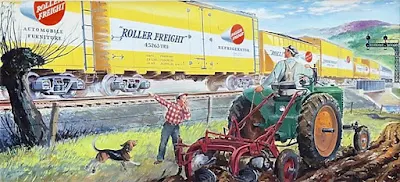Sometime in the mid-1940s, the Timken Roller Bearing Company purchased one or more freight cars, applied roller-bearing trucks, and painted it (or them) in vivid paint scheme(s). One report is that these cars were exhibited at one or more railroad fairs, others that they were moved around the country on various railroads for publicity purposes.
Certainly one of the cars was exhibited at the Chicago Railroad Fair of 1948–49. Below is a photo of the car at that fair, from an internet site (you can visit it at: https://www.railarchive.net/rrfair/rrfair4869.htm ).
It is hard to get much more specific than what you read above. About 20 years ago, Bob Weston wrote, on one of the on-line forums, this comment: “The Timken Roller Bearing Company painted several freight cars in color schemes to promote its products. I've seen pictures of two boxcars in different schemes. Or was it one boxcar in two schemes? One car was done in conjunction with the Akron, Canton & Youngstown RR, I believe it was numbered 600. There was also a gondola painted in red and white and blue. I’ve also heard that a tank car may have been painted for the Timken Co.”
The photo above proves that there was at least one car, a 1937-AAR design box car built for Timken in a one-car order by AC&F. It was evidently originally painted green, but soon became yellow with the wide white stripe and Timken logo. It was then numbered TRBX (for Timken Roller Bearings) 88, but one source references a TRBX 81; or maybe there were two cars. The car which became AC&Y 600 was transferred after 1950 but before 1953. (The Timken plant was in Canton, Ohio.)
Back in the days of Athearn metal car kits, there was a model of a Timken box car, though Athearn first advertised the version with red instead of yellow sides. Note in the page below, from the 1948 catalog, that Athearn mentions “You’ve seen this car in all the national magazines – now have it on your layout.” (Catalog page from the “HO Seeker” site: https://hoseeker.net/AthearnBrochuresAds/brochure1948pg1.jpg ) The car number appears to be 88.
There is evidence that the red scheme was at least something promoted by Timken, whether or not it was applied to an actual car; below is a 1947 ad from Railway Age (maybe one of the “national magazines” mentioned by Athearn). These cars have three-digit numbers. Note that the white stripe is lower in this artwork than in the Athearn model photo above.
Athearn’s red scheme car was joined later by an Athearn metal model in the yellow scheme, as you see in the Internet photo below, also numbered TRBX 88. The roof is supposed to be black.
By the 1953 catalog, Athearn offered not only the yellow and red
schemes, but also a silver Timken box car scheme. That was included in
their 1954 catalog as well, but by 1957 all Timken cars were absent. Here’s an internet photo of an Athearn model in the silver scheme:
Athearn also did one of their 12,500-gallon metal tank cars in the yellow scheme, and I have one of them. These were never pictured in an Athearn catalog, but they were listed in the catalogs from 1948 through 1954, inclusive. In 1957 Athearn had dropped them from the listing. Like all the Athearn metal tank cars, they have nice two-rung sill steps and free-standing tank hold-downs.
These Athearn metal cars are from the modeling era when imaginary paint schemes were still rare, so I give them some credence.
It is interesting that on the web one can find a couple of paintings by a prolific artist named John F. Gould. These might have been commissioned by Timken. They show dramatic views of Timken rolling stock, though I have no idea which or how many cars really got painted this way. Below is one example (the fifth car back is a tank car). To see the variety of Gould’s work, you can visit https://johngouldart.com/gallery/ .
So I can’t find firm information about how many or which kinds of freight cars may really have worn these Timken schemes, nor how long they lasted. I only operate my Timken tank car occasionally, and only in through trains. But I’d like to know more.
Tony Thompson







0 Comment